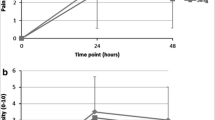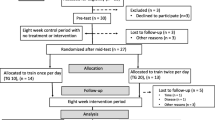Abstract
The objective of this explorative study was to investigate to what extent changes in perceived pain, induced by myofeedback training, are correlated to changes in muscle activation patterns. Thirty subjects with work-related myalgia received myofeedback training. Before (T0), directly after (T1) and 4 weeks or, in a subset of patients, 3 months after (T2) this training, surface electromyography (sEMG) measurements of the upper trapezius muscle were performed during standardized computer tasks; a typing and a stress task. Besides this, visual analogue scales (VAS) were filled in to assess the levels of pain in the neck and shoulders. From the sEMG, root mean square (RMS) and relative rest time (RRT, i.e. the percentage of time RMS is below a certain threshold) were used for data analysis. The relationships between RRT, RMS and VAS at T0 as well as for the changes between T1–T0 and T2–T0 were investigated using Spearman correlation coefficients. The results revealed no significant correlations between VAS and RMS both at baseline (range R =−0.22 to 0.17) and for the observed changes (range R =−0.33 to 0.32). Also, for VAS and RRT, low correlations were found for baseline (range R =−0.27 to 0.21) and for changes between T1–T0 (range R =−0.02 to 0.38). However, for the changes between T2–T0, correlation coefficients for the VAS for the shoulder and the RRT of the right trapezius during both the typing and stress tasks were significant at the P =0.05 level, whereas the correlation coefficients for the VAS for the neck and both the left and right trapezii during the stress task approached significance ( P =0.05 and P =0.1, respectively). These results suggest that decreases in pain observed at long term follow up after myofeedback training might occur as a result of an increased ability to relax but not as a result of decreased muscle activation level. However, the largest correlation found was 0.6. This means that the maximal explained variance ( R 2) is low (36%), and that there are also other processes than the changes in muscle activation that contribute to changes in perceived pain.


Similar content being viewed by others
References
Arena JG, Bruno GM, Hannah SL, Meador KJ (1995) A comparison of frontal electromyographic biofeedback training, trapezuis electromyographic biofeedback training, and progressive muscle relaxation therapy in the treatment of tension headache. Headache 35:411–419
Gift A (1989) Visual analogue scales: Measurement of subjective phenomena. Nurs Res 38:286–288
Hägg GM, Åström A (1997) Load pattern and pressure pain threshold in the upper trapezius muscle and psychosocial factors in medical secretaries with and without shoulder/neck disorders. Int Arch Occup Environ Health 69:423–432
Hasenbring M (1999) When die seele auf die bandscheiben drückt. Medizin 1:43–48
Hermens HJ, Hutten MMR (2002) Muscle activation in chronic pain: its treatment using a new approach of myofeedback. Indust J Ergon 30:325–336
Hermens HJ, Freriks B, Merletti R, Stegeman D, Blok J, Rau G, Disselhorst-Klug C, Hagg G (1999) European recommendations for surface electromyography: results of the SENIAM project. Roessingh Research and Development, Enschede
Mathiassen SE, Winkel J, Hagg GM (1995) Normalisation of surface EMG amplitude from the upper trapezius muscle in ergonomic studies: a review. J Electromyogr Kinesiol 5:197–226
Nederhand MJ, Hermens HJ, IJzerman MJ, Turk DC, Zilvold G (2002) Cervical muscle dysfunction in chronic whiplash associated disorder grade II—the relevance of the trauma. Spine 27:1056–1061
Rockicki LA, Holroyd KA, France CR, Lipchik GL, France JL, Kvaal SA (1997) Change in mechanisms associated with combined relaxation/EMG biofeedback training for chronic tension headache. Appl Psychophysiol Biofeedback 22:21–41
Sandsjö L, Melin B, Rissén D, Dohns I, Lundberg U (2000) Trapezius muscle activity, neck and shoulder pain, and subjective experiences during monotonous work in women. Eur J Appl Physiol 83:235–238
Stuckey SJ, Jacobs A, Goldfarb J (1986) EMG biofeedback training, relaxation training, and placebo for the relief of chronic back pain. Percept Mot Skills 63:1023–1036
Veiersted KB (1994) Sustained muscle tension as a risk factor for trapezius myalgia. Int J Indust Ergon 14:333–339
Veiersted KB, Westgaard RH, Andersen P (1993) Electromyographic evaluation of muscular work pattern as a predictor of trapezius myalgia. Scand J Work Environ Health 19:284–290
Acknowledgements
This work was undertaken within the project Neuromuscular Assessment in the Elderly Worker (NEW), with partial financial support from the EC within the RTD action QLRT 2000 00139.
Author information
Authors and Affiliations
Corresponding author
Rights and permissions
About this article
Cite this article
Vollenbroek-Hutten, M., Hermens, H., Voerman, G. et al. Are changes in pain induced by myofeedback training related to changes in muscle activation patterns in patients with work-related myalgia?. Eur J Appl Physiol 96, 209–215 (2006). https://doi.org/10.1007/s00421-004-1212-4
Accepted:
Published:
Issue Date:
DOI: https://doi.org/10.1007/s00421-004-1212-4




